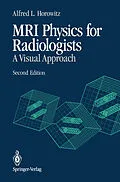When this book was initially published three years ago, it was my goal to delineate the principles of magnetic resonance imaging in a format that could be understood without a sophisticated physics or mathematics back ground. That is still my goal. However, in the interim, it has become clear to me that many magnetic resonance techniques that we now routinely use are inadequately understood by many of us. Therefore, I have re-structured and expanded the book in the following way. There are now three main sections: of the sections one and two deal with the contrast and spatial characteristics image, as they did in the original text; and an additional section deals with various peripheral but significant magnetic resonance topics. Sections one and two still provide the "meat" of the material through the guise of the spin-echo pulse sequence; but section three goes beyond by explaining other pulse cycles and devices that are commonly used in today's imaging centers. To begin with, since fast scanning has now become a widely used tech nique, that chapter has been significantly expanded, and now includes a complete but non-mathematical explanation of what a gradient echo is and how fast scan images differ in principle from spin-echo images. Also, the applications of 3DFT and "half-Fourier" imaging are graphically covered without mathematical intervention.
Inhalt
Section 1-Image Contrast.- Overview.- Magnetic Field.- Fields.- Basic Types of Magnets.- Permanent Magnet.- Superconducting Magnet.- Vectors.- Paramagnetic, Diamagnetic, Ferromagnetic.- Angular Momentum-Nuclear Spin.- Magnetic Dipole Moment.- Resultant M Vector.- Precession and the Larmor Equation.- Radiofrequency Pulse.- Electromagnetic Waves.- Periodic Functions.- Axis Conventions.- Perturbance of the M Vector.- Rotating Frame of Reference.- Resonance.- M vs the Component MDM Vectors.- The Signal and the Mx Vector.- Controlling the Flip of M.- Motion of M in the X-Y Plane.- Relaxation.- T1 and T2 Components of Relaxation.- T1 Curves.- Pulse Cycles, Pulse Sequences and Tissue Contrast.- TR and TE.- T1 and T2 Weighting.- Balanced (Spin Density) Scans.- T2 and the Spin-echo Pulse Cycle.- Graph of MR Signal-free Induction Decay (FID).- Envelopes of the Signal.- T2*.- Concept of Phase.- Phase and the MR Signal.- Dephasing and the MR Signal.- Rephasing the MR Signal-180° Refocusing Pulse.- The Spin-echo Pulse Cycle.- The True T2 Curve.- T2 Curves for Different Tissues for Long TR'S.- T1 and T2 Constants.- T2 Curves for Different Tissues for Short TR'S.- Section 2-The Image in Space.- Gradients.- The Slice Select Gradient.- Changing Slice Thickness.- Frequency Gradient.- The Pixel Grid.- Sine Functions for Each Pixel.- Application of Frequency Gradient.- The Fourier Transform.- The Spectrum.- The Fourier Series.- Fourier Transform of Pixel Grid.- Rotating Gradients-One Alternative.- The Phase Encoding Gradient.- Degrees of Phase Shift Per Row.- Phase Shift in Sine Functions.- Simple Summary of Phase Ideas.- Multiple Repetitions to Form the Image.- Phase Encoding Repititions and the Pixel Grid.- Phase Encoding Repetitions and the MDM.- Inside the "Black Box": From Signal to Image.- (1) -Repetition-time Matrices.- (2) -Phase-frequency Matrices.- (3) -Transformation to Image-the 2DFT.- Wrapping Up Basic Concepts.- The Gradients in Perspective.- Imaging in Other Planes.- The Multislice Technique.- Averages, Excitations.- Exam Time.- General Wrap-up.- Section 3-Miscellaneous Topics.- Some Other Pulse Cycles and Procedures.- Saturation Recovery and Partial Saturation.- Inversion Recovery.- Fast Scans.- Pulse Cycle Summary.- Three Dimensional Fourier Imaging.- Half Fourier Imaging.- Motion.- General Considerations.- Flowing Blood.- Time-of-flight Phenomena.- Phase-related Phenomena.- Turbulence.- Even and Odd Echo Effects.- Flow-related Enhancement.- Magnetic Resonance Angiography (MRA).- Maximum Intensity Projection Algorithm.- Projection Acquisition.- Methods to Combat Motion Artifacts.- Pre-saturation.- Cardiac Gating.- Respiratory Ordered Phase Encoding.- Gradient Moment Nulling.- Aliasing.- Aliasing in the Phase Encoding Axis.- Aliasing in the Frequency Encoding Axis.- Fat and Water.- Chemical Shift Artifact.- Method of Dixon.- Selective Spectral Excitation.- Stir Sequences.- Coils.- Receiver, Transmitter Coils.- Gradient Coils.- Shim Coils.- User Parameter Summary.
